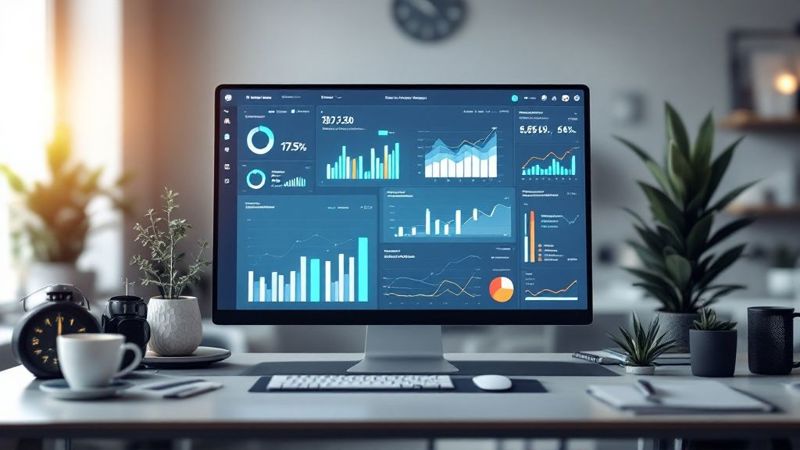Demystifying Click-Through Rate: What Really Matters

Before we explore ways to improve your click-through rate, let's define what CTR means for your business. Click-through rate is the percentage of people who see your link and actually click on it. This seemingly simple metric has a big impact on your digital marketing efforts. It influences your bottom line across various channels, including search engine results pages (SERPs), email marketing campaigns, and social media platforms.
Why CTR Is So Important
CTR isn't just about vanity. It tells you how well your content connects with your target audience. A high CTR suggests your content is relevant, engaging, and meets user needs.
For instance, a high CTR on a search engine result page means your title tag and meta description accurately represent the information searchers are looking for. Similarly, a good CTR on your social media posts suggests that your visuals and copy are resonating with your followers. This increased engagement leads to more website traffic, greater brand visibility, and, ultimately, higher conversions.
Setting Realistic CTR Benchmarks
It's crucial to remember that CTR benchmarks differ significantly across industries. Some sectors naturally have higher CTRs due to things like product demand and audience behavior. Highly competitive industries like online retail often see lower average CTRs compared to niche markets with less competition.
Therefore, setting realistic goals based on your specific industry and marketing channel is essential. Comparing your CTR to unrelated industries can be misleading and discouraging.
Historical CTR Trends and Context
Historically, click-through rates have fluctuated greatly based on the advertising type and its placement. In the early days of online advertising, banner ad CTRs were often above 5%. Now, these rates average around 0.2% to 0.3%.
Search ads, being more targeted and relevant to user searches, typically have higher CTRs. The global average was about 1.63% in the second quarter of 2024. Learn more about click-through rates on Wikipedia. Even within search ads, CTR can change based on factors like keyword competition and ad position.
The Relationship Between CTR and Conversions
A high CTR is great, but it's not the only measure of success. The ultimate goal is conversions, whether that's a purchase, sign-up, or another desired action.
Focusing only on boosting CTR without considering conversions can be counterproductive. A campaign with a high CTR but low conversions is ineffective. The key is to find a balance where a good CTR translates into a solid conversion rate. This maximizes your return on investment. This complex relationship highlights the importance of understanding the true meaning of click-through rate.
Crafting Headlines That Demand Attention

Your audience makes split-second decisions about clicking on your content, heavily influenced by your headline. This makes crafting compelling headlines crucial for boosting your click-through rate (CTR). This article explores the art of irresistible headlines, using real-world examples and insights into the psychology of clicking.
The Psychology of Clicking
Think of your headline as a first impression. It must grab attention and offer value to entice a click. This involves understanding your audience's motivations. Are they seeking solutions, information, or entertainment? Addressing these needs in your headline is the first step.
For instance, a headline like "5 Proven Strategies to Boost Your Email Open Rates" addresses a specific problem and offers actionable solutions. This is much more compelling than a generic "Email Marketing Tips."
Headline Formulas That Work
Some headline structures consistently outperform others. These formulas provide a framework for writing attention-grabbing headlines without resorting to clickbait. Let's explore a few of these proven formulas.
To further illustrate these effective headline formulas, let's look at some examples in a table format:
High-Converting Headline Formulas This table presents battle-tested headline structures that consistently generate above-average click-through rates across various marketing channels.
| Headline Formula | Example | Best For | Average CTR Lift |
|---|---|---|---|
| Numbers | 7 Unexpected Ways to Improve Your Writing | Blog posts, listicles | Can increase CTR by up to 20% |
| Questions | Is Your Website Mobile-Friendly? | Lead generation, problem-solving content | Can boost engagement and pique curiosity |
| How-to's | How to Write a Blog Post That Ranks on Google | Tutorials, guides | Clearly signals valuable, actionable content |
As the table demonstrates, using numbers, questions, and how-to formats in your headlines can significantly improve their performance. These formulas provide clear expectations and pique reader interest.
A/B Testing: Refine Your Approach
Crafting effective headlines is a continuous process. A/B testing with tools like Google Optimize allows you to compare different versions and identify the top performer. This data-driven approach helps refine your headlines based on actual audience behavior.
Even small tweaks, like rephrasing a key phrase, can significantly impact your CTR. Analyzing your A/B testing data reveals what resonates most with your audience, allowing you to continuously optimize your headlines and maximize your click-through rates.
Beyond the Click: Delivering on Your Promise
A captivating headline is essential for attracting clicks, but it's equally important to deliver on its promise. Clickbait might generate initial clicks, but it ultimately damages your credibility and leads to high bounce rates.
Ensure your content provides real value and meets the expectations set by your headline. This builds trust with your audience and encourages future engagement. Remember, your headline is the gateway; the true value lies in your content's quality.
Meta Descriptions: Your Untapped Conversion Tool

Meta descriptions, often overlooked, are crucial for attracting clicks from search engine results pages. Think of them as concise advertisements for your web page. They provide a brief overview of your content, enticing users to click and learn more. A well-crafted meta description can significantly improve your click-through rate (CTR).
Why Meta Descriptions Matter for CTR
Search results pages are like a digital storefront. Your page title is the shop sign, but the meta description is the persuasive window display that draws customers in. It offers context and a glimpse of what awaits them inside. A missing or poorly written meta description can negatively impact your CTR, sending potential visitors elsewhere.
Imagine searching for "best hiking boots." A result with a bland description like "Hiking boot information" is less appealing than one stating, "Find the perfect hiking boots for your next adventure. Expert reviews, top brands, and buying guides." The latter offers clear value and encourages clicks.
Crafting Compelling Meta Descriptions
Effective meta descriptions require understanding search engines and user behavior. Consider these key strategies:
- Incorporate Keywords: Use relevant keywords naturally. This helps search engines understand your page's topic and match it to user searches.
- Highlight Benefits: Clearly communicate the value proposition. What will users gain by visiting your page?
- Include a Call to Action: Encourage clicks with phrases like "Learn more," "Shop now," or "Read the review."
- Optimal Length: Aim for around 150-160 characters to prevent truncation in search results.
- Accuracy is Key: Ensure your meta description accurately reflects the page content. Misleading descriptions lead to higher bounce rates.
Tailoring Meta Descriptions for Different Content
Different content types require different meta description approaches. A product page needs a distinct strategy compared to a blog post or a landing page.
- Product Pages: Emphasize key features, benefits, and any special offers to drive sales.
- Blog Posts: Summarize the main topic, highlight key takeaways, and pique reader interest.
- Landing Pages: Clearly state the page's purpose and the desired user action.
A recent study by Backlinko shows the importance of comprehensive content for attracting clicks. Top-ranking pages often feature in-depth content, indicating that thoroughness resonates with searchers. Increasing click-through rates is also linked to content relevance and quality. Google prioritizes informative and relevant content, leading to improved rankings and higher CTRs.
You might also find this helpful: How to Increase Click Rate in Email Marketing With Personalized Images
Auditing and Revitalizing Your Existing Meta Descriptions
Regularly review and update your meta descriptions, especially for underperforming pages. Google Search Console helps track your CTR and pinpoint areas for improvement. A/B testing different meta description variations can reveal what resonates best with your audience. Even small changes can have a substantial impact on your click-through rate.
Visual Content That Triggers Action

Visuals are essential for capturing attention and encouraging engagement online. They have a significant impact on your click-through rate (CTR), whether in search results, social media posts, or email campaigns. This discussion explores how visuals influence user behavior and offers practical strategies to optimize your visual content.
The Neuroscience of Visual Processing and Clicking
Our brains process images significantly faster than text. This speed advantage gives visuals a powerful edge in those crucial moments when a user decides whether to click. Engaging images create emotional connections, quickly conveying complex information and encouraging clicks.
For example, a vivid image of a tempting dish is far more effective in a restaurant advertisement than a simple text description. The image immediately engages the viewer's senses and appetite. Similarly, visuals in blog post thumbnails give users a quick understanding of the content, helping them decide whether to read more.
Visual Elements That Drive Engagement
Some visual elements are especially effective at capturing attention and generating clicks. Here's a breakdown:
- High-Quality Images: Blurry or pixelated images appear unprofessional and can discourage clicks. Always use sharp, clear visuals.
- Relevant Imagery: Your images should directly connect with the content. Mismatched visuals create confusion and erode trust.
- Color Psychology: Colors evoke emotions and create associations. Select colors that align with your brand and message. Green often suggests health and nature, while blue projects trust and stability.
- Visual Storytelling: Use images to tell a story and create a compelling narrative that leads users toward a click. This could involve a sequence of images illustrating a process or a single image conveying a strong emotion.
Optimizing Visuals for Different Contexts
The best visual approach depends on the platform and the content you're promoting. Consider these context-specific tips:
- Search Results Thumbnails: Create visually distinctive images that stand out from the competition. This is your first impression, so make it memorable.
- Social Media Previews: Use eye-catching images and videos optimized for each platform's dimensions.
- Email Campaigns: Personalized images, such as those generated with OKZest, can dramatically improve email CTR. Dynamic data allows you to address each subscriber individually, boosting engagement.
Technical Optimization Strategies
Optimizing visuals for fast loading and cross-device compatibility is critical for improving click-through rates. Large image files can slow down page loading, leading to user frustration and lost clicks.
Ensure your visuals display correctly on different screen sizes. This prevents distorted images and delivers a positive user experience on all devices. By following these technical best practices, you can remove obstacles to clicks and maximize your CTR. Combining these principles with the other strategies discussed will help create compelling visuals that naturally encourage clicks.
Creating Ad Copy That Connects and Converts
Generic ad copy rarely performs well. To truly grab attention and encourage clicks, your messaging needs to resonate with your target audience. This means understanding their needs, motivations, and pain points at each stage of their buying journey. Just as you'd speak differently to a friend than a business colleague, your ad copy should adapt to each audience segment.
Aligning Messaging With User Search Intent
Before writing any ad copy, consider the search intent behind your targeted keywords. What are users searching for? Are they researching, comparing products, or ready to buy?
For example, someone searching for "best running shoes for marathon training" is likely closer to purchasing than someone searching for "how to choose running shoes." The first user is further down the sales funnel. Your ad copy should reflect these differences, offering relevant information and calls to action for each stage.
Balancing Emotion and Logic in Your Ads
Effective ad copy blends emotional appeals with rational benefits. While logic and facts are important, connecting with your audience on an emotional level can be incredibly powerful. Consider highlighting the joy, comfort, or security your product provides.
However, don't rely solely on emotion. Support your claims with concrete benefits and data. Instead of claiming "Our software is amazing," try "Our software increases productivity by 25%." This quantifiable benefit appeals to a more rational mindset.
Using Dynamic Keyword Insertion and Responsive Search Ads
To make your ad copy even more relevant, consider dynamic keyword insertion (DKI) and responsive search ads. Dynamic keyword insertion automatically adds the user's search query into your ad, creating a personalized experience. Responsive search ads allow you to test multiple headlines and descriptions. Google then optimizes to find the highest performing combinations. These techniques tailor your messaging to individual searches.
To understand how these strategies can improve your click-through rate (CTR), let's look at industry benchmarks.
Understanding CTR Benchmarks Across Digital Channels
This table compares average click-through rates across different marketing channels, helping you identify effective platforms and set realistic performance targets.
| Marketing Channel | Average CTR | Industry Variation | Trend |
|---|---|---|---|
| Search Ads | 1-5% | Highly variable based on industry and competition | Declining |
| Display Ads | 0.35% | Varies by targeting and ad format | Relatively stable |
| Social Media Ads | 1-3% | Dependent on platform and audience engagement | Fluctuating |
| Email Marketing | 2-4% | Influenced by list quality and email content | Generally stable |
Key takeaway: While search ads can offer a higher CTR compared to display ads, it's crucial to optimize your campaigns continuously. The wide industry variation highlights the importance of tailoring your strategy to your specific niche.
Optimizing Your Ad Copy for Conversions
Ultimately, your ad copy's goal is conversions. A high click-through rate is great, but it's meaningless if clicks don't lead to desired actions. Continuously test and refine your copy, focusing on key metrics. This might involve A/B testing different headlines, calls to action, or benefit statements. Analyze the results, identify what works, and iterate to maximize your return on investment. Riseopp offers more detailed click-through rate statistics. Crafting compelling ad copy is an ongoing process.
A/B Testing Strategies That Drive Real Results
Most A/B tests fall short of producing meaningful click-through rate (CTR) improvements because they target the wrong elements. By analyzing thousands of successful tests, we can identify the components that consistently yield the biggest gains when optimized effectively. This post will guide you in developing a strategic testing roadmap that prioritizes these high-impact elements, avoiding endless minor tweaks.
Prioritizing High-Impact Elements for A/B Testing
Instead of randomly testing different elements, concentrate on those with the most potential to influence CTR. Headlines, for instance, are often the first and only thing users notice. A small change here can significantly impact engagement. Your call to action (CTA) is another critical element. It's the pivotal point where a user decides to convert.
Optimizing your CTA button color, text, or placement can dramatically improve results. Prioritizing A/B testing efforts on these key elements – headlines and CTAs – is often more effective than tweaking less impactful aspects. For instance, changing body text font might not yield the same CTR lift as a rewritten headline.
Designing Tests for Statistically Significant Results
Even with limited traffic, you can design effective A/B tests. This involves defining clear goals and metrics before starting. Are you aiming for a 5% CTR increase or a 10% increase in conversions? Knowing your target lets you accurately measure the impact of changes.
Also, ensure your tests run long enough to gather sufficient data for statistically significant results. This avoids decisions based on temporary fluctuations in traffic or user behavior.
Interpreting Data and Avoiding Common Pitfalls
Analyzing A/B testing data correctly is essential for informed decisions. Avoid common mistakes like prematurely ending tests or misinterpreting statistical significance. A small improvement doesn't guarantee a winner. Ensure results are consistent and reliable before implementing campaign-wide changes.
Fundamental and Advanced A/B Testing Methods
A/B testing encompasses various methodologies, each suited to different situations. Simple split tests compare two versions of an element, like two different headlines. This is an excellent starting point for most optimization efforts.
For more complex scenarios, multivariate testing allows simultaneous testing of multiple variations. However, multivariate tests require significantly more traffic for reliable results. The right methodology depends on your traffic volume, change complexity, and testing goals. For further insights on improving email marketing click-through rates, check out this helpful resource: Boost Your Email Marketing Success: Click-Through Rates, Customer Engagement, and Personalized Emails
Real-World Case Studies and Transformations
Many businesses have significantly improved their click-through rates through systematic A/B testing. One company boosted their email CTR by 20% by simply changing their CTA button color. Another saw a 15% lift in website conversions by testing different headline variations.
These examples demonstrate the potential of strategic A/B testing. By learning from these successes and implementing a data-driven approach, you can significantly improve your own CTR and achieve your marketing objectives.
Action-Oriented CTAs That Seal the Deal
Your call to action (CTA) is the crucial link between sparking interest and prompting action. It's the decisive moment when a potential customer chooses to click and journey further down your sales funnel. Understanding the psychology behind effective CTAs is the key to boosting your click-through rate. This involves carefully considering button design, placement, copy, and the surrounding context.
The Psychology of Clicking: Understanding User Behavior
Eye-tracking studies reveal valuable insights into how users interact with web pages and where their attention is drawn. This data informs effective CTA placement strategies. Placing your CTA above the fold, immediately visible without scrolling, often leads to higher click-through rates.
However, for longer pages requiring more context, strategically positioning the CTA further down the page can be more impactful. The key takeaway? Tailor your approach to the specific content and the user's journey.
Button design also significantly influences click behavior. A contrasting color that pops against the background, clear and concise text, and an appropriate size are all essential factors. A bright red button on a predominantly white background, coupled with text like "Get Started Now," effectively draws attention and communicates the intended action. Think of your CTA button as a clear signpost guiding users to the next step.
You might be interested in: How to write emails that people will actually read.
Crafting Action Language That Converts
The words you choose for your CTA are just as important as the design. Action-oriented language that creates a sense of urgency without being pushy is essential. Instead of a generic "Submit," try using phrases like "Download Now," "Get Your Free Trial," or "Claim Your Discount." These CTAs clearly communicate value and encourage immediate action.
Avoid manipulative tactics that erode trust. While phrases like "Limited Time Offer" or "Don't Miss Out" can be effective, overuse breeds skepticism. Focus on providing genuine value and build trust with your audience.
Customizing CTAs for Different Audiences and Stages
One-size-fits-all CTAs rarely yield optimal results. Different audience segments respond to different messaging. A seasoned marketer might be drawn to "Advanced Analytics," while a beginner might prefer "Learn the Basics."
Similarly, tailor your CTA to the user's stage in the customer journey. Someone browsing your blog might be receptive to "Subscribe to Our Newsletter," while someone on a product page is more likely to click "Add to Cart."
Advanced Strategies: Personalized and Context-Sensitive CTAs
Personalized CTAs that address users by name or reference their past interactions can significantly improve click-through rates. This personalization creates a sense of connection and relevance.
Context-sensitive CTAs adapt to the user's current behavior or the content they're viewing. For example, on a blog post about social media marketing, a relevant CTA might be "Boost Your Social Media Engagement." This targeted approach often outperforms static CTAs.
Implementing these advanced strategies often requires the right tools. OKZest allows you to create dynamic, personalized images for your email campaigns and web pages. This customization empowers you to tailor your CTAs to individual users and contexts, dramatically increasing engagement and conversions. Learn more about how OKZest can help you boost your click-through rate by visiting https://okzest.com.